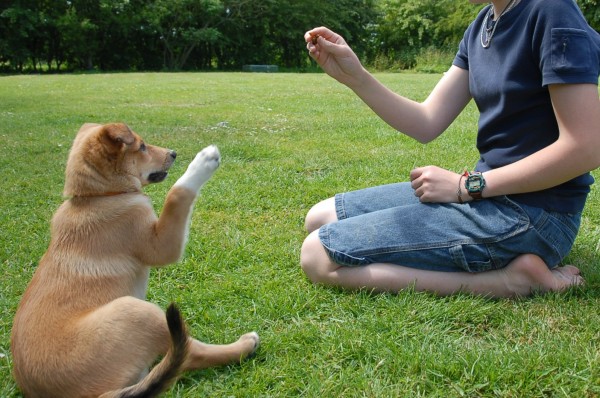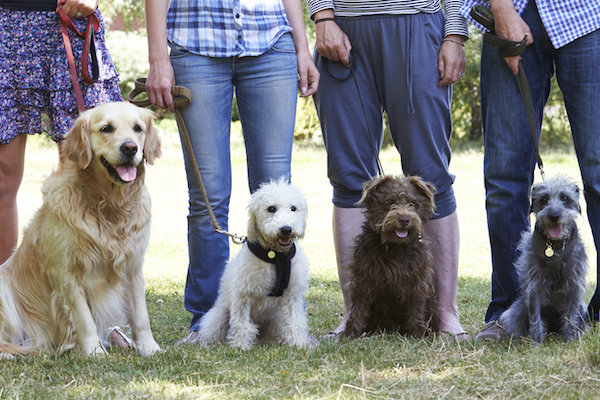Most — if not all — dog trainers have had at least one dog in their lives who inspired them to enter the field of animal behavior. For me, I learned from the mistakes I made with our first dog, Chilli, and then I had my eyes opened to the world of fear and anxiety with the “baggage” that came with one of our other dogs, Sadie.
Unfortunately, there are no regulations in the dog training industry, so literally anyone can hang a shingle and call themselves a trainer. Despite this, most trainers agree that there are best practices when it comes to becoming a professional dog trainer.

1. Learn about dog behavior
For some, this means enrolling in animal behavior coursework at a school, but for me, it all started with reading some well-respected books about animal behavior:
- Excel-Erated Learning: Explaining in Plain English How Dogs Learn and How Best to Teach Them by Pamela J. Reid
- The Other End of the Leash: Why We Do What We Do Around Dogs by Patricia B. McConnell
- Culture Clash: A New Way of Understanding the Relationship Between Humans and Domestic Dogs by Jean Donaldson
- Don’t Shoot the Dog: The New Art of Teaching and Training by Karen Pryor
- The Power of Positive Dog Training by Pat Miller
I also enrolled in the Companion Animal Sciences Institute (which I highly recommend) for a solid foundation in canine behavior; hence the Dip. CBST after my name. I know many trainers who took their coursework at the Animal Behavior College (ABC). Both programs are online-based, but ABC includes an internship, which is nice. I have heard that the mentors can be hit or miss and aren’t always proponents of positive reinforcement, so that is something to consider. Other options include the Karen Pryor Academy for those interested in clicker training, which is offered in-person around the United States, and the Academy for Dog Trainers by the well-respected Jean Donaldson. The Academy is not in-person, but it requires you to send in videos demonstrating your skills.
2. Get some experience
Volunteering at an animal shelter is a great way to get experience around animals, and if it has a training department that you can observe or help out with, even better! If you have a positive-reinforcement trainer near you who offers an internship or mentorship, check that out, or get a job with a store like PetSmart or Petco, where they will train you and give you some good experience.
3. Evaluate your own skills and motivation
As you may know, dog training isn’t that much about working with dogs — it’s about training humans to work with their dogs. It can be very helpful to have people skills in addition to dog training skills.

After you gain some experience, consider your strengths and weaknesses. Do you love puppy socialization classes but not basic ones? Do you love basic classes but not those that teach advanced skills? Are you interested in agility?
And last but not least, do you want to be a business owner? If you are motivated to be an entrepreneur, you will want to learn about basic bookkeeping and marketing, and you will need to register your business. If not, start looking for companies that might be hiring entry-level dog trainers.
4. Get your business set up
Assuming you want to start your own dog-training business, the next step is to get your ducks in a row, which includes:
- Registering your business name and getting a business license
- Getting your Federal Business Tax ID (also called an EIN, which is essentially a social security number for your business)
- Setting up social media
- Getting business cards
- Getting an accountant or at least financial software
- Setting up your client contracts and policies
- Getting dog-trainer liability insurance
- Setting your fees and packages
- Determining where to hold classes/private sessions/etc.
This is by no means a comprehensive list.
Also, here are three great books to pick up about the actual business part of dog training:
- How to Run a Dog Business: Putting Your Career Where Your Heart Is by Veronica Boutelle
- So You Want to be a Dog Trainer by Nicole Wilde
- It’s Not the Dogs, It’s the People! A Dog Trainer’s Guide to Training Humans by Nicole Wilde.
- Nicole also offers a Dog Trainer’s Business Kit on her website, which has customizable handouts, contracts, client questionnaires, and more. It can save you a ton of time trying to write up that stuff on your own!
5. Consider professional memberships and certifications
Dog training is not regulated, but there is a certification that you can get once you accumulate enough private sessions and group class hours. It’s called the CPDT-KA, which stands for Certified Professional Dog Trainer – Knowledge Assessed. You get it by sending in proof of your experience and taking a lengthy exam. You can also work to become a certified animal behaviorist through the International Association of Animal Behavior Consultants. (Note: While anyone can call herself a “behaviorist,” it is a general rule in the industry that only those with a graduate degree in animal behavior are qualified to use this title.)
Also, you can join a handful of professional groups for development opportunities, networking, or even to get liability insurance. The Association of Professional Dog Trainers (APDT) is the best-known group and is open to trainers of all styles and backgrounds. Another group is the Pet Professional Guild (PPG), which is a group for force-free trainers only.
Whatever path you take toward becoming a dog trainer, it’s important to have a network of fellow trainers that you can look to for guidance — and to refer cases you aren’t ready to handle. If you refer a case, ask if you can observe the sessions so that you can increase your skills and knowledge!





